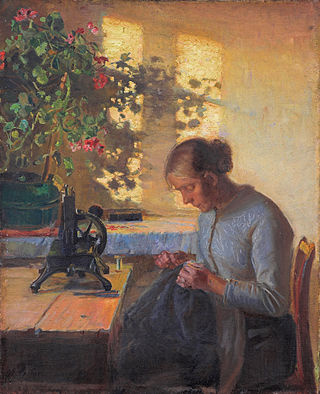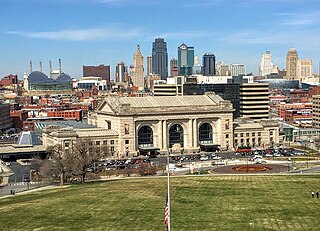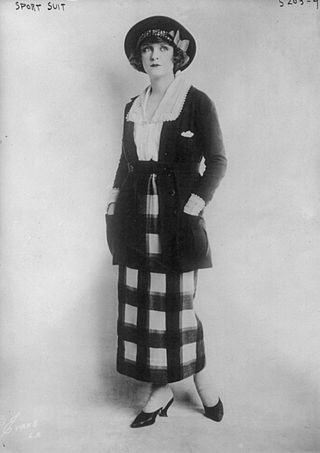
A sewing machine is a machine used to sew fabric and materials together with thread. Sewing machines were invented during the first Industrial Revolution to decrease the amount of manual sewing work performed in clothing companies. Since the invention of the first sewing machine, generally considered to have been the work of Englishman Thomas Saint in 1790, the sewing machine has greatly improved the efficiency and productivity of the clothing industry.

Sewing is the craft of fastening or attaching objects using stitches made with a sewing needle and thread. Sewing is one of the oldest of the textile arts, arising in the Paleolithic era. Before the invention of spinning yarn or weaving fabric, archaeologists believe Stone Age people across Europe and Asia sewed fur and leather clothing using bone, antler or ivory sewing-needles and "thread" made of various animal body parts including sinew, catgut, and veins.

A codpiece is a triangular piece that attached to the front of men's hose, covering the fly. It may be held in place by ties or buttons. It was an important fashion item of European clothing during the 15th–16th centuries, in the 16th century becoming a firm upwards-pointing projection based on a stiff material such as boiled leather, or in plate armour, steel.

A cardigan is a type of knitted sweater that has an open front, and is worn like a jacket.

A temple garment, also referred to as garments, the garment of the holy priesthood, or Mormon underwear, is a type of underwear worn by adherents of the Latter Day Saint movement after they have taken part in the endowment ceremony. Garments are required for any individual who previously participated in the endowment ceremony to enter a temple. The undergarments are viewed as a symbolic reminder of the covenants made in temple ceremonies and are seen as a symbolic and/or literal source of protection from the evils of the world.

The Garment District, also known as the Garment Center, the Fashion District, or the Fashion Center, is a neighborhood located in the borough of Manhattan in New York City. Historically known for its role in the production and manufacturing of clothing, the neighborhood derives its name from its dense concentration of fashion-related uses. The neighborhood, less than 1 square mile, is generally considered to lie between Fifth Avenue and Ninth Avenue, from 34th to 42nd Streets.

Downtown Kansas City is the central business district (CBD) of Kansas City, Missouri and the Kansas City metropolitan area which contains 3.8% of the area's employment. It is between the Missouri River in the north, to 31st Street in the south; and from the Kansas–Missouri state line eastward to Bruce R. Watkins Drive as defined by the Downtown Council of Kansas City; the 2010 Greater Downtown Area Plan formulated by the City of Kansas City defines the Greater Downtown Area to be the city limits of North Kansas City and Missouri to the north, the Kansas–Missouri state line to the west, 31st Street to the south and Woodland Avenue to the east. However, the definition used by the Downtown Council is the most commonly accepted.

The American Theatre Wing is a New York City–based non-profit organization "dedicated to supporting excellence and education in theatre", according to its mission statement. Originally known as the Stage Women's War Relief during World War I, it later became a part of the World War II Allied Relief Fund under its current name. The ATW created and sponsors the Tony Awards in theatrical arts.

Arthur Bryant's is a restaurant located in Kansas City, Missouri. It is considered by some to be the most famous barbecue restaurant in the United States.

Needles and Pins is an American sitcom about a women's clothing manufacturer and his employees in New York City that aired from September 21, 1973, to December 28, 1973.

Kansas City–style barbecue is a slowly smoked meat barbecue originating in Kansas City, Missouri in the early 20th century. It has a thick, sweet sauce derived from brown sugar, molasses, and tomatoes. Henry Perry is credited as its originator, as two of the oldest Kansas City–style barbecue restaurants still in operation trace their roots back to Perry's pit.
The study of the history of clothing and textiles traces the development, use, and availability of clothing and textiles over human history. Clothing and textiles reflect the materials and technologies available in different civilizations at different times. The variety and distribution of clothing and textiles within a society reveal social customs and culture.

Fashion design is the art of applying design, aesthetics, clothing construction and natural beauty to clothing and its accessories. It is influenced by culture and different trends, and has varied over time and place. "A fashion designer creates clothing, including dresses, suits, pants, and skirts, and accessories like shoes and handbags, for consumers. He or she can specialize in clothing, accessory, or jewelry design, or may work in more than one of these areas."

Outside Western cultures, men's clothing commonly includes skirts and skirt-like garments; however, in the Americas and much of Europe, skirts are usually seen as feminine clothing and socially stigmatized for men and boys to wear, despite having done so for centuries. While there are exceptions, most notably the cassock and the kilt, these are not really considered 'skirts' in the typical sense of fashion wear; rather they are worn as cultural and vocational garments. People have variously attempted to promote the fashionable wearing of skirts by men in Western culture and to do away with this gender distinction.

Palestinian traditional clothing are the types of clothing historically and sometimes still presently worn by Palestinians. Foreign travelers to Palestine in the 19th and early 20th centuries often commented on the rich variety of the costumes worn, particularly by the fellaheen or village women. Many of the handcrafted garments were richly embroidered and the creation and maintenance of these items played a significant role in the lives of the region's women.

Sportswear is an American fashion term originally used to describe separates, but which since the 1930s has come to be applied to day and evening fashions of varying degrees of formality that demonstrate a specific relaxed approach to their design, while remaining appropriate for a wide range of social occasions. The term is not necessarily synonymous with activewear, clothing designed specifically for participants in sporting pursuits. Although sports clothing was available from European haute couture houses and "sporty" garments were increasingly worn as everyday or informal wear, the early American sportswear designers were associated with ready-to-wear manufacturers. While most fashions in America in the early 20th century were directly copied from, or influenced heavily by Paris, American sportswear became a home-grown exception to this rule, and could be described as the American Look. Sportswear was designed to be easy to look after, with accessible fastenings that enabled a modern emancipated woman to dress herself without a maid's assistance.

Yeohlee Teng is an American fashion designer originally from Malaysia and of Chinese heritage. She received the Smithsonian's Cooper-Hewitt National Design Award for fashion design in 2004. Her work has been displayed at the Metropolitan Museum of Art, New York and Victoria & Albert, London.

The Kansas City Garment District Museum is located in the Garment District, in the lobby of DST Systems Inc.'s Poindexter Building. It is a part of the Kansas City Museum.
Clothing industry or garment industry summarizes the types of trade and industry along the production and value chain of clothing and garments, starting with the textile industry, embellishment using embroidery, via the fashion industry to apparel retailers up to trade with second-hand clothes and textile recycling. The producing sectors build upon a wealth of clothing technology some of which, like the loom, the cotton gin, and the sewing machine heralded industrialization not only of the previous textile manufacturing practices. Clothing industries are also known as allied industries, fashion industries, garment industries, or soft goods industries.

Sheep Piece is a sculpture by Henry Moore made in three sizes from 1969-1972, starting in 1969 with a 14 centimetres (5.5 in) maquette modelled in plaster and then cast in bronze, enlarged in 1971 to a 142 centimetres (56 in) working model in plaster and then cast in bronze, and finally a full size bronze on a monumental scale, 570 centimetres (220 in) high, cast in 1971-72. The four full-size casts are at the Henry Moore Foundation in Perry Green, Hertfordshire, in Zürich, in Kansas City, and at the Donald M. Kendall Sculpture Gardens in Purchase, New York.


















